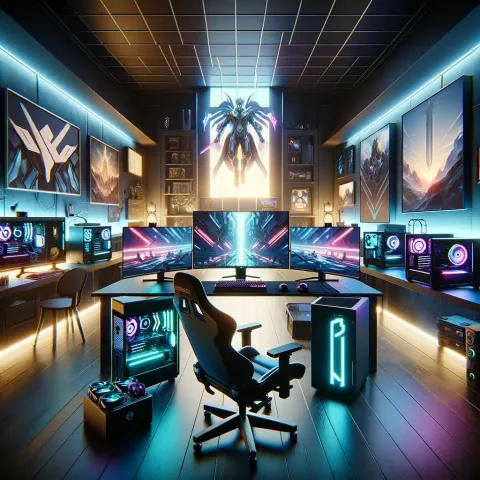Guides
19:05, 09.10.2024
9

The topic of FPS is constantly causing controversy in the gaming community. Someone wants to squeeze out maximum performance by sacrificing graphics and visuals that Riot Games worked so hard on. Some people are willing to sacrifice stability for a beautiful image. All of these settings are influenced by many factors, such as the power of your hardware, your preferences, and how you want to play Valorant. In this article, we will look at settings for Valorant optimization.
System requirements for Valorant
System requirements directly affect the game's performance on your device. If you do not comply with the developer's requirements, you may have problems launching the game.
Before moving on to any Valorant fps settings, make sure your device meets the developer's current requirements.
Valorant Minimum System Requirements:
- Operating system: Windows 7, Windows 8.1, Windows 10 (64-bit)
- Processor: Intel Core 2 Duo E8400, AMD Athlon 200GE
- RAM: 4 GB
- Video card: Intel HD 4000 (1 GB), AMD Radeon R5 200
- Disk space: 26 GB
If your device has this hardware or higher, you can easily run and play Valorant with minimal settings.
Recommended system requirements for Valorant:
- Operating system: Windows 10 (64-bit)
- Processor: Intel Core i5-4150, AMD Ryzen 3 1200
- RAM: 8 GB
- Video: NVIDIA GeForce GTX 1050 Ti, AMD Radeon RX 560
- Disk space: 26 GB
These requirements are based on game performance at 1920x1080 resolution and 60fps frame rate. To achieve higher frame rates, you will need more powerful hardware.
Best hardware for Valorant
The best hardware setup for Valorant depends on several factors, including your individual preferences and budget. However, in general, here are some recommendations that will help you play Valorant to the fullest:
- Processor: Valorant is a CPU-dependent game, so you will need a powerful enough processor to ensure a smooth gameplay. Recommended processor is Intel Core i5-9400F or AMD Ryzen 5 3600.
- Video Card: The video card also plays an important role in the performance of Valorant. Recommended graphics card: Nvidia GeForce RTX 2060 or AMD Radeon RX 5700.
- RAM: RAM is used to store data used by the game. The recommended amount of RAM is 16 GB.
- Storage: Valorant requires ample space to store game files. Recommended memory size is 50 GB.
- Monitor: A monitor with a high refresh rate can help improve the smoothness of the game. The recommended refresh rate is 144Hz or higher.
If you want the best performance in Valorant, you'll need a computer with these or more powerful components. However, if you are on a budget, you will still be able to play Valorant on a lower graphics level.

Best FPS Settings in Valorant
One of the very first and most important points will be setting the quality of Valorant graphics; it has the greatest impact on the performance of the game.
Valorant Basic Settings
Texture Quality: | Set this to Low or Medium. High texture quality requires more resources but doesn't provide significant in-game advantages. |
Screen Resolution: | Set this to 1920x1080 or 1600x900. Higher resolutions will look better but demand more resources. |
Frame Rate: | Set this to 60 or 120. A higher frame rate makes the game smoother. |
Anti-aliasing: | Choose MSAA 4x or FXAA. Anti-aliasing helps reduce jagged edges on objects. |
Anisotropic Filtering: | Set this to 16x. Anisotropic filtering helps improve image clarity. |

By following these few simple tips, you can achieve the best Valorant settings for FPS, both on console and PC.
Is it possible to enable FPS display in Valorant?
Without further ado, we will answer you, yes. Just go to Valorant in the video settings section, you need to find the statistics item. Once there, you will need to select “FPS Client”, by turning it on you will receive a text display of your FPS in the lower left corner of the screen.
Best Graphics Quality Settings in Valorant
In addition to the main settings, Valorant has an additional tab. Here you can find many parameters that have a big impact on Valorant performance settings.
Frame Rate Limit: | Enable the menu and in-game frame rate cap to be 10-20 points higher than your monitor's refresh rate. This will help prevent performance degradation. |
HRTF: | Turn on “HRTF” to improve the spatial perception of sound. |
Digital Intensity: | Set this value to Low or Medium. A high digital intensity value may cause image blur. |
Nvidia Reflex: | If you have an Nvidia graphics card, enable Nvidia Reflex. This technology will help reduce input lag. |
Blood: | Turn off blood if you want to improve performance. |
Stroke: | Set this value to Medium or Low. A high stroke value may result in poor performance. |
Raw Input Buffer: | Enable Raw Input Buffer to provide more precise cursor control. |
Map Centering: | Turn on map centering to ensure your cursor is always in the center of the screen. |

By following these settings, you will achieve better game performance, but Valorant graphics quality settings will suffer slightly.
Experimental settings:
Valorant also offers several experimental tweaks that can improve performance or add new visual effects. These settings are still under development and may result in game instability. However, if you want to achieve the best graphics settings for Valorant, you simply must test this functionality, because if something goes wrong, you can always disable them.
Experimental Sharpening: | Turn on Experimental Sharpening to improve image clarity. |
Texture Quality Enhancement: | Enable Texture Quality Enhancement to increase texture detail. |

Tips for Hardware Settings for Valorant
If your device meets the minimum or recommended requirements, but you still encounter certain difficulties when starting or playing games, follow these short instructions. This will help clean up your hardware and achieve a better Valorant FPS setup.
- Set the correct graphics settings. Lowering your graphics settings can help improve performance without greatly affecting the visual appearance of the game. More details about this are written above.
- Update your hardware drivers. Drivers may contain performance improvements that can help improve FPS in Valorant. You can download the latest drivers for your hardware from the manufacturer's website.
Downloading Nvidia Drivers
- Clear your computer of junk. A cluttered computer can slow down your productivity. Remove unnecessary files and programs to free up space and resources.
- Close background applications. Background applications can consume resources, which can affect Valorant performance. Close all unnecessary applications before starting the game.
If you follow these tips, you will be able to improve Valorant performance on your computer.

Bottom line
If you want maximum performance, you should set all settings to Low. This will ensure a smooth game even on weak computers. However, if you want better visual quality, you can adjust some settings to Medium or High.
You can also experiment with different settings to find what suits you best. For example, if you feel the game is getting too blurry, you can increase the Anisotropic Filtering value. Or, if you feel like you're having trouble seeing enemies in the distance, you can increase the Texture Quality value.
Ultimately, the answer to the question “how to optimize Valorant?” very simple, follow a few simple tips that will once and for all save you from problems with FPS drop.
Here are some specific recommendations for increasing FPS in Valorant:
- If you have a weak computer, set all settings to Low.
- If you have a medium computer, you can adjust some settings to Medium.
- If you have a powerful computer, you can set some settings to High.
- Turn off the blood if you want to improve your performance.
- Reduce your screen resolution if you want to improve performance.
- Set the frame rate limit 10-20 points higher than your monitor's refresh rate.
- Enable Nvidia Reflex if you have an Nvidia graphics card.
You can also try using third-party programs to optimize game performance. Programs like Razer Cortex: Game Booster and MSI Afterburner can help reduce the load on your computer and improve FPS.
Upcoming Top Matches
Latest top articles







Comments7